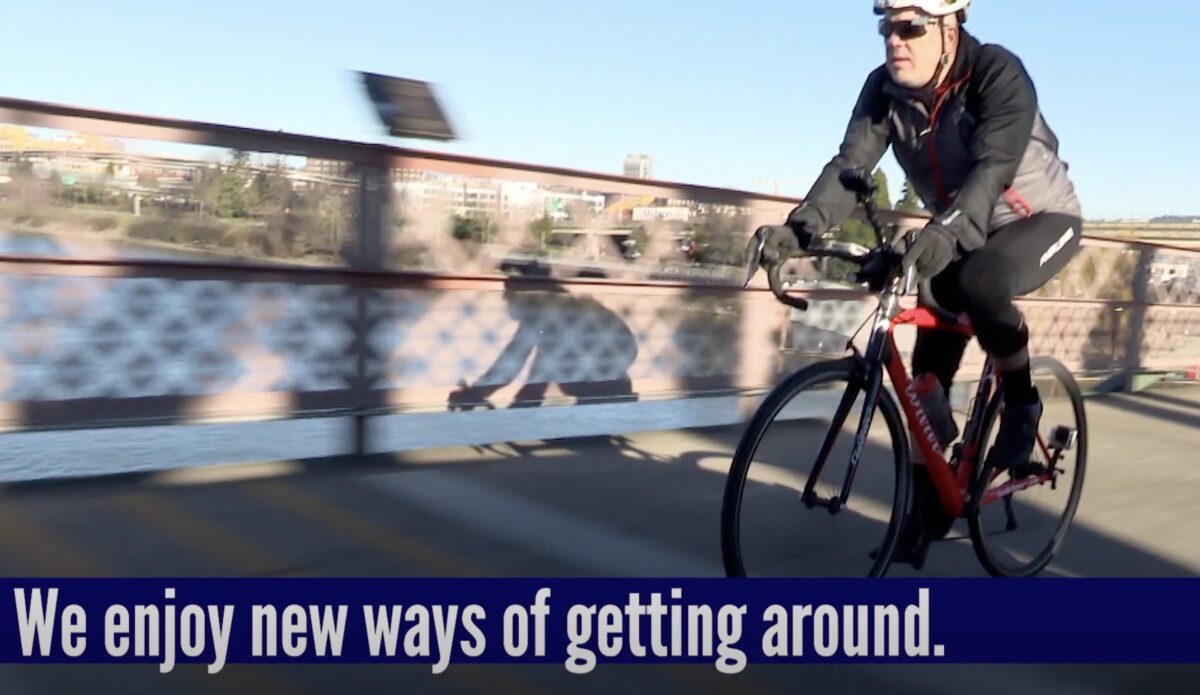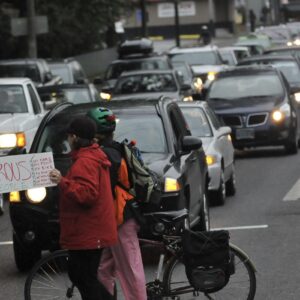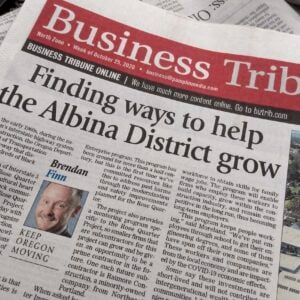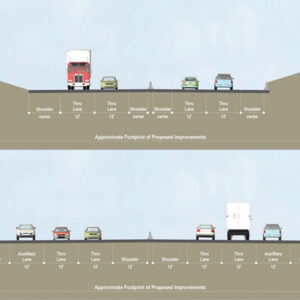
(Graphic: ODOT Strategic Action Plan)
“In order to create this system and meet the demands ahead, ODOT must evolve.”
— from Strategic Plan introduction letter
The Oregon Department of Transportation is the largest barrier to significant reform of our transportation system. The agency holds the pursestrings and levers of power that dictate just how quickly we can move from a driving and highway-dominated infrastructure and policy framework, to a more humane and earth-friendly one.
The agency’s 2021-2023 Strategic Action Plan, adopted by the Oregon Transportation Commission late last year, is a window into what ODOT thinks of itself and what steps they’ll take to reform themselves. Part policy and part propaganda, it can also be used as a tool for Oregonians to hold the agency accountable.
Advertisement
“Oregon’s transportation system of the future… will offer a wide range of mobility choices to promote a healthy environment and respond to the diverse mobility needs of those who use the transportation system, including those that the system has not served well in the past,” reads an introduction to the 26-page plan signed by OTC Chair Bob Van Brocklin and ODOT Director Kris Strickler. “In order to create this system and meet the demands ahead, ODOT must evolve. An organization with the tools, ideas, and perspectives of the past is unprepared to meet the needs of the future… Change starts now.”
A short video introduction to the plan (below) was released on Tuesday.
Amid a backdrop of droning meditative music, a graphic in the photo claims our transportation system was, “Born in 1913.” That date aligns with the formation of the State Highway Commission, but it glosses over the fact that several Oregon cities already had functioning transportation systems without cars or highways. Portland and Eugene had trolleys and streetcars long before the Highway Commission was established. And let’s not forget the detailed road network illustrated in the “Cyclists Road Map of Portland District” published in 1896. That’s the same year Portland’s Union Station opened for business.
This might feel like nitpicking (something I admittedly tend to do when covering government agencies), but the perspective that cars and highways are the foundation of Oregon’s transportation system reinforces their primacy. This is how the status quo maintains its power. It didn’t go unnoticed to me that the photo in the video accompanied by “We enjoy new ways of getting around,” showed a man on a bicycle, as if bicycle riders are some strange new interloper, when the reality is that bicycles dominated roads throughout Oregon long before the first car was ever sold.
To ODOT’s credit, the Strategic Action Plan calls for a “transformation,” and “change” which can (charitably) be read as an admission that the agency is currently on the wrong track.
The meat of the plan are three “Priority Areas” and 10 “Strategic Outcomes”.
The three priorities are: “Modern Transportation System” (and yes people likely have different ideas of what “modern” means), “Sufficient and Reliable Funding” (especially important if you like to build expensive freeways), and “Equity”.
Advertisement
The 10 strategic outcomes include very admirable goals:
1. Increase Our Workforce Diversity
2. Implement a Social Equity Engagement Framework
3. Reduce Our Carbon Footprint
4. Electrify Oregon’s Transportation System
5. Improve Access to Active and Public Transportation
6. Reduce Congestion in the Portland Region
7. More Dollars to Black, Indigenous, People of Color and Women Owned Businesses
8. Implement Transformative Technologies
9. Implement Large-scale Road Usage Charging
10. Achieve Sufficient Funding
When it comes to reducing their carbon footprint, ODOT promises that by the end of 2023 they’ll “begin to reduce greenhouse gas emissions from ODOT activities.” ODOT also says that starting next year they’ll, “Adjust investment programs to invest in lower emission projects (e.g. bike, walk, transit).”
As for improving access to active transportation and public transit, ODOT promises that by the end of 2023 they will, “increase the percentage of agency funding dedicated to projects and programs that improve equitable access to walking, biking and transit.”
Advertisement
We’ve already seen some action from ODOT on both of these fronts. The new priority to reduce GHG emissions came into play with the latest Statewide Transportation Improvement Program (STIP) funding allocation decision. Last month the OTC voted to spend a record amount on “non-highway” projects.
The biggest debates in the next three years are likely to be around how ODOT plans to “Reduce congestion in the Portland region” while staying true to the goals outlined in this plan. Undeterred by widespread local opposition, the Strategic Plan boldly proclaims ODOT will begin construction on the I-5 Rose Quarter project by 2023 and will, “Begin making investments in the Portland region to reduce traffic congestion as defined by the average number of hours per day a driver experiences congestion.”
If ODOT undertakes that work with the, “tools, ideas, and perspectives of the past” they won’t meet their goals. A planning document has never been enough for ODOT to make the real and lasting changes our state needs — it must be accompanied by pressure from outside leaders and the public.
— Jonathan Maus: (503) 706-8804, @jonathan_maus on Twitter and jonathan@bikeportland.org
— Get our headlines delivered to your inbox.
— Support this independent community media outlet with a one-time contribution or monthly subscription.






Thanks for reading.
BikePortland has served this community with independent community journalism since 2005. We rely on subscriptions from readers like you to survive. Your financial support is vital in keeping this valuable resource alive and well.
Please subscribe today to strengthen and expand our work.
“We enjoy new ways of getting around.” Invention of mass produced cycles: 1860s. Invention of mass produced car: 1910s. Wow ODOT.
Odot wasn’t formed until 1969, from a previous commission formed in 1913.
https://en.wikipedia.org/wiki/Oregon_Department_of_Transportation
Why anticipate changes in Oregon? They allow studded car tires.
“The Oregon Department of Transportation is the largest barrier to significant reform of our transportation system.”
I’m sorry, but I disagree. It’s your state legislature and governor who are your biggest barriers to significant reform of your transportation system, as well as the voters who keep electing them. ODOT (and PBOT) are simply bureaucratic agencies carrying out the misguided policies given to them by your representative government.
I genuinely don’t understand the vilification of ODOT that happens on this blog. Sure, they’re not perfect, but I have yet to see evidence that they’re actively inhibiting progress. Their recent Outer Powell project can only be viewed as a success, they’d like to transfer their urban arterials to PBOT (who is refusing to accept them), and their work on trails like the HCRH has been amazing. And compare them to pretty much any other state DOT and ODOT look like saints.
I think ODOT is doing some goods thing, but I also think they are doing some bad things. It is possible for me to criticize and compliment an agency at the same time — especially one as large and sprawling as ODOT. I’ve shared many positive stories and comments about ODOT on these same pages when the situation warrants it.
Given what I know I feel my characterization of ODOT is accurate. If the agency went through major reforms and cultural changes (starting with upper management), we could usher in an entirely new era. This is not a simple topic. I realize that. There are a lot of nuances to my thoughts on ODOT!
When I was an advocate in Portland I often would work with ODOT officials and staff. To misquote a recent banana republican, there were good people on both sides. Since I moved out here to NC, I’ve had several conversations with senior NCDOT staff who regularly study other state DOTs. Generally they are in awe of MinnDOT and ColoradoDOT for innovative roadway safety solutions, and WaDOT and UtahDOT in their ability to get more money from state voters. They have a contempt for ODOT and a few others for an apparent inability to fund and build new and badly needed freeways; for being far too liberal with the bike and ped lobby; and for being a net gainer of federal largess (North Carolina gives more than they receive.)
I’m not saying that ODOT is perfect – every bureaucracy has lots of room for improvement. But I agree with Unnamed, compared with most state DOTs, ODOT as an organization are relative saints.
Well, that’s one metric, but taxes are only one way to measure federal largess:
https://wallethub.com/edu/states-most-least-dependent-on-the-federal-government/2700
Overall, Oregon & North Carolina are pretty even in their usage of federal funds. Oregon may not pay as much in, but they also don’t get the big government contracts like NC. (Oregon ranks #5 in the lowest amount of federal contracts.)
I meant highway money, but I don’t disagree. The many huge military bases here in NC are a scourge – they not only corrupt their immediate communities with very high crime – but veterans dominate the civilian civil service of most NC cities and NCDOT. Veterans are great at taking orders and doing all that they are ordered to do, thoroughly, but they lack the imagination when dealing with marginalized peoples and they are terrible when it comes to transit, bike, and ped projects – why would anyone not drive? And yet they are in charge of our transit, bike, and ped programs; ditto in SC, Georgia, Florida, Alabama, and lots of other states. Guess which states are consistently the worst to take transit, bike, or walk in?
By the by, I wouldn’t put too much faith in the website you cited – garbage in equals garbage out and all that. I was looking up a ranking they have for best/worst US cities for taxes versus services and my horrible city of Greensboro came in 12the best/150, which I find utter BS. DC was the worst, which is also utter BS. And Boise was number 1.
Many, many folks around the country have a very distorted view of Oregon as some sort of liberal paradise. Sounds like senior NCDOT staff are not immune to this phenomenon either.
You are correct, they are not immune, and neither are our elected officials. We all look to Portland to inspire us on how we can make our cities more bike-friendly – any ground-breaking improvements you make have huge national knock-on effects in other cities, major and minor. We all read in our newspapers and watched on TV/internet the daily detailed Portland riot reports with great interest. There are lots of ex-Portlanders here in NC, including many who are BIPOC from inner NE. As for the negatives in Portland, we too have a rapidly growing homeless population, police brutality, incompetent city and state leadership (except in our largest city of Charlotte), record pedestrian deaths (but not so bad with bicyclists – on the other hand we have far fewer bicyclists to kill), crazier car drivers, etc.
David, I disagree with your statement: “It’s your state legislature and governor who are your biggest barriers to significant reform of your transportation system, as well as the voters who keep electing them.”
You are being willfully disingenuous, since you know that legislators come and go, but bureaucracies are forever. The car-dominant culture of ODOT endures from one administration to another, and no Governor or legislator can do much to change that culture.
I’m so glad to see JM taking a long view of ODOT’s work, since that’s what’s needed to change the culture of the organization. Yes, we need to elect progressive legislators and executives – they can help to drive change. But it’s entirely appropriate to maintain a laser-focus on ODOT itself.
Thanks for the reply. My statement was more directed at other commenters than you; I should’ve made that clearer 🙂
I think it’s both… But there are plenty of examples that back up my point. I disagree that ODOT are simply innocent bureaucrats. They establish the narratives that OTC members and state legislators gobble up without scrutiny.
I wouldn’t use the word “innocent” with very many bureaucrats (though I have met a few), but I would use the word “naive” for quite a lot of the middling sort – they really have no notion of the enormous impacts of their administrative decisions they make on projects and how it affects people in general and bicyclists in particular. And I do agree with you, the upper management does to a certain extent manipulate the conversations (and thus policies) of state legislators and the executive decision-makers, but it’s often hard to figure out who is manipulating whom, and why they are doing it. Keep in mind that many elected officials depend on “donations” to fund campaigns and may themselves be directly or indirectly invested in the transportation industrial complex.
Do the representative governments guide them to not address damaged fence for months after they are made aware?
I hope they take to heart “3. Reduce Our Carbon Footprint” and mean Oregon’s not ODOT’s
ODOT has opened new Climate Business Line and given well intentioned people offices, but where power lies is demonstrated in where money is spent. Magical thinking like “more lanes = less pollution “. Is well funded. Decisive or innovative green infrastructure, not so much. New Climate initiative is empty rhetoric until it is funded beyond just supporting press releases.
As far as Portland area is concerned, they missed a big one. Maybe try getting to cut fences and electrical device tampering in less than a few months and keep existing bike paths usable as intended when they were built. Before they build any more big stuff and do big projects, they need to triple the maintenance and enforcement efforts. Increase maintenance department. Spend money on private patrol to kick out unauthorized activities before they get too big. The plus side is that some of that cost would be covered by reductions in the IGA cleanup expenses they have to pay to the city by preventing the mess from getting too big in the first place.
It really would be nice if I-205 path and that path along Sunset highway were kept clear at all times of junk/debris and other hazards.
New evidence shows that Congestion helps save lives, because cars are forced to go slower. Therefore, DO NOT reduce congestion! I recommend increasing it until cars cannot exceed 25 MPH inside cities. This would save $Millions! ALL Public Transit should have dedicated lanes where packed carriers could attain speeds of 50 MPH. Drivers would rapidly learn to ride Transit.